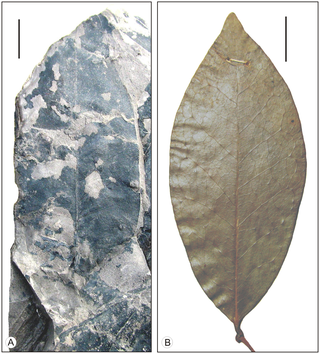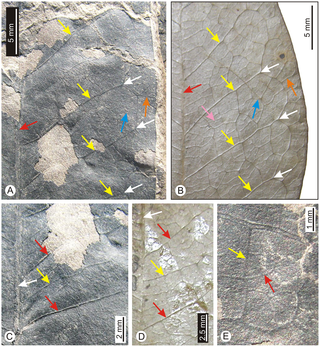A new fossil leaf impression of Alphonsea Hk. f. & T. of the family Annonaceae is described from the Late Oligocene sediments of Makum Coalfield, Assam, India. This is the first authentic record of the fossil of Alphonsea from the Tertiary rocks of South Asia. The Late Oligocene was the time of the last significant globally warm climate and the fossil locality was at 10°–15°N palaeolatitude. The known palaeoflora and sedimentological studies indicate a fluvio-marine deltaic environment with a mosaic of mangrove, fluvial, mire and lacustrine depositional environments. During the depositional period the suturing between the Indian and Eurasian plates was not complete to facilitate the plant migration. The suturing was over by the end of the Late Oligocene/beginning of Early Miocene resulting in the migration of the genus to Southeast Asia where it is growing profusely at present. The present study is in congruence with the earlier published palaeofloral and molecular phylogenetic data. The study also suggests that the Indian plate was not only a biotic ferry during its northward voyage from Gondwana to Asia but also a place for the origin of several plant taxa.

Alphonsea leaves.
A. Fossil leaf of A. makumensis sp. nov. showing shape, size and venation pattern. B. Modern leaf of A. lutea showing similar shape, size and venation pattern (Scale bar = 1 cm).
doi:10.1371/journal.pone.0053177.g003

Alphonsea leaves.
A. Enlarged portion of the fossil leaf showing primary vein (red arrow), secondary veins (yellow arrows), brochidodromous venation (white arrows), random reticulate tertiary vein (blue arrow) and exmedial tertiary vein (orange arrow). B. Enlarged portion of the modern leaf of A. lutea showing similar primary vein (red arrow), secondary veins (yellow arrows), brochidodromous venation (white arrows), random reticulate tertiary vein (blue arrow), exmedial tertiary vein (orange arrow) and quadrangular areole (pink arrow). C. Enlarged portion of the fossil leaf showing primary vein (white arrow), secondary veins (red arrows) and intersecondary vein (yellow arrow). D. Modern leaf of A. lutea showing similar primary vein (white arrow), secondary vein (red arrows) and intersecondary vein (yellow arrow). E. Enlarged portion of the fossil leaf showing single quadrangular areole (yellow arrow) and free veinlets (red arrow).
doi:10.1371/journal.pone.0053177.g004
Citation: Srivastava G, Mehrotra RC (2013) First Fossil Record of Alphonsea Hk. f. & T. (Annonaceae) from the Late Oligocene Sediments of Assam, India and Comments on Its Phytogeography. PLoS ONE 8(1): e53177. doi:10.1371/journal.pone.0053177
Editor: Subho Mozumdar, University of Delhi, India



 March 15th, 2013
March 15th, 2013  Riffin
Riffin  Posted in
Posted in  Tags:
Tags: 